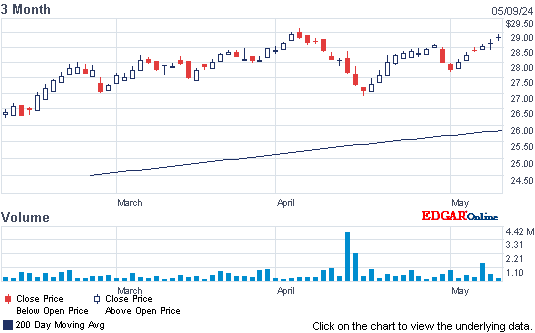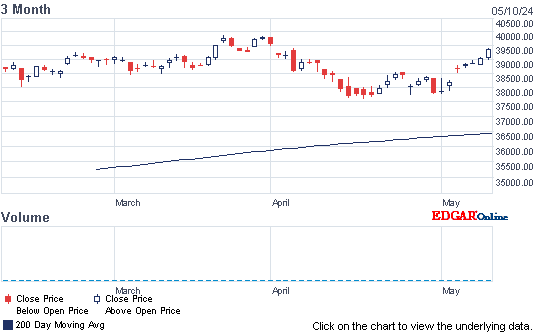Dow lost 7, decliners over advancers 5-4 & NAZ went iup 11. The MLP index did little in the 322s & the REIT index was fractionally lower in the 351s. Junk bond funds crawled higher & Treasuries were in demand. Oil is back up into the 53s & gold rose to 1284.
AMJ (Alerian MLP Index tracking fund)

Once again, stocks are not doing much of anything. Consumer confidence remains high & unemployment claims are low. The stock market likes to see that, but has had a minor retreat in the last 6 weeks. Earnings season kicks off today with big banks leading the way. Hopes are high but results may fall short. Today's gut reaction is indecisive.
Dow Jones Industrials

AMJ (Alerian MLP Index tracking fund)
Wholesale prices in the US declined in Mar for the first time since Aug 2016, a sign broader inflation will accelerate only gradually, a Labor Dept report showed. The producer-price index decreased 0.1% (forecast was for no change) following a 0.3% advance the prior month. From a year earlier, wholesale prices were up 2.3% (forecast was 2.4%), the most in 5 years, after a 2.2% gain. Excluding food and energy, the PPI was unchanged from the prior month & was up 1.6% from Mar 2016. ¾ of the decrease in PPI was due to a drop in final demand services. A tempering of wholesale prices indicates price pressures are only slowly building in the production pipeline as stabilization in the global economy generates more demand for industrial materials. While inflation met the Fed's 2% goal in Feb, according to the central bank's preferred measure, some officials focus more on the gauge excluding food & energy, which is still below their target. Energy prices dropped 2.9% from previous month & food costs rose 0.9%. PPI goods prices decreased 0.1% after a 0.3% increase. Wholesale prices of services also fell 0.1% following a 0.4% rise the prior month. Excluding volatile components such as food, energy & trade services, producer costs rose 0.1% from prior month, & increased 1.7% from a year earlier. A 4.1% decrease in prices of loan services led the Mar drop in final demand services. Retail margins in apparel, footwear & accessories declined, as did those for securities brokerage & trucking.
U.S. Producer Prices Decline for First Time Since August 2016
Consumer sentiment advanced to a 3-month high in Apr as Americans' optimism about their current financial situation & the economy reached the strongest point since 2000, Univ of Mich survey data showed. Preliminary sentiment index rose to 98 (forecast was 96.5) from 96.9 in Mar. Current conditions gauge, which measures Americans' perceptions of their personal finances, increased to 115.2, the highest since 2000, from 113.2 the prior month. Expectations measure improved to 86.9 from 86.5. Americans have kept up a solid run of optimism, supported by a labor market that's still humming & confidence that growth-boosting policies will take shape under the Trump administration. Some 52% of respondents reported that their finances had recently improved, the highest share since 2000. The more favorable assessment reflected higher incomes & wealth, as well as low prices. The report hinted that households would respond to greater optimism by making big purchases. Perceptions of favorable conditions for purchases of durable goods were cited by 82% of respondents, the largest share since 2005. Nevertheless, the expectations measure remains divided along party lines, as 69% of Reps cited favorable news about employment & economic policies, compared with only 28% among Dems. “Much more progress on shrinking the partisan gap is needed to bring economic expectations in line with reality,” Richard Curtin, director of the survey, said. The report also showed “year-ahead inflation expectations remained at 2.5% in Mar & Apr, & well below last year's 2.8%. These lows were supported by the fewest complaints that rising prices eroded their living standards,” he said.
U.S. Consumer Sentiment Climbs on Upbeat Assessment of Economy
Fewer Americans than forecast filed for unemployment benefits last week, with applications hovering just above a 4-decade low, a Labor Dept report showed. Jobless claims decreased 1K to 234K (forecast was 245K) in the latest week. The number of people continuing to receive jobless benefits dropped 7K to 2.03M. The current level of claims is the lowest since they reached a 44-year low of 227K in the week ended Feb. 25. Applications for jobless benefits remain firmly entrenched in a downtrend since breaking below the 300K level in Mar 2015, consistent with a tightening labor market that's put a premium on experienced workers & shows employers are still unwilling to pare headcounts. The 4 week average of initial claims, a less-volatile measure than the weekly figure, fell to 247K from 250K in the prior week. The unemployment rate among people eligible for benefits held at 1.5%
Fewer Americans Than Forecast File for Unemployment Benefits
Once again, stocks are not doing much of anything. Consumer confidence remains high & unemployment claims are low. The stock market likes to see that, but has had a minor retreat in the last 6 weeks. Earnings season kicks off today with big banks leading the way. Hopes are high but results may fall short. Today's gut reaction is indecisive.
Dow Jones Industrials













No comments:
Post a Comment